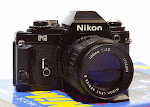F-stops control the diameter of your diaphragm (aperture). The f-stops are clearly marked on the lower ring of your lens. (Some new lenses designed for digital cameras will not have this ring.
For now on we will refer to the iris opening as the aperture. The f-stops control the aperture.

Opening up one full f-stop doubles the amount of light entering the camera. Closing down one full f-stop cuts the light in half.
f/2.8 lets in twice the amount of light as f/4, f/4 lets in twice the amount of light as f/5.6, f/5.6 lets in twice the amount of light as f/8, and so forth.
A typical f-stop sequence wil look like this:
f/1.4 - f/2.8 - f/4 - f/5.6 - f/8 - f/11 - f/16 - f/22
The full range of f-stop number :
f/1 - f/1.4 - f/2 - f/2.8 - f/4 - f/5.6 - f/8 - f11 - f/16 - f/22 - f/32 - f44 - f64
Becoming familiar with your f-stops is very important. Knowing the full sequence of f-stops will be a valuable tool in the future.
A helful tip is to remember that with minor varitations, each whole f-stop is twice the f-stop that is two stops back.
Take a look at the sequence above.
f/1 will let in the greatest amount of light while f/64 will let in the least light.
Knowing this we will now move on to lens speed. Lens speed simply refers to the greates amount of light your lens will let in.
A fast lens is a lens that allows in greater portions of light and a slow lens refers to lenses that let in small anounts of light.
A typical fast lens would be f/1.2 - f/1.4 - f/1.8
These apertures allow for much more light to enter the camera.
Slower lenses such as f/2 - f/2.8 - f/3.5, let in smaller portions of light.
When more light enters your camera the less time is needed to expose the film or activate your digital sensor to record an image. Slower lenses need more time to record the image.
A typical fast f/1.4 Fujinon lens.

I hope you can see why we call f/1.2 and f1.4 fast lenses.

No comments:
Post a Comment